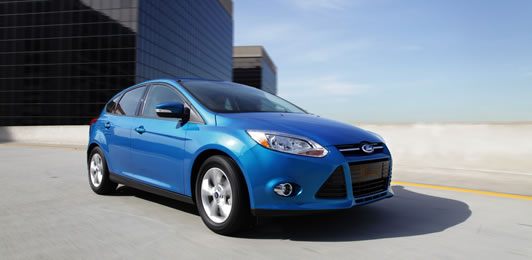Balancing Our Portfolio Profitably
To meet the demand for more fuel-efficient vehicles and increase our financial health, we have been balancing the portfolio of vehicles we sell to better represent consumer demand for a variety of vehicle sizes and capabilities. We are leveraging our global product strengths to deliver six new world-class small and medium-sized vehicles to the U.S. over the next four years. And, we are targeting sales leadership in “people movers” and crossovers by adding new vehicles (such as the Ford Flex) and redefining existing vehicles (such as the Ford Explorer). Through these actions, we have aligned our product mix more closely with the broader industry.
In 2004, cars and crossovers represented only 35 percent of Ford sales volumes, with trucks and SUVs claiming 65 percent. By 2010 we had nearly reversed that balance, with car and crossover sales representing up to 57 percent of our overall sales volumes.

The 2012 Ford Focus
Small cars like the Ford Fiesta and Ford Focus now represent one in five new vehicle sales in the U.S., up from 14 percent of the market in 2004. Although we believe that the shift to smaller, more fuel-efficient vehicles is permanent, trucks, vans and SUVs will continue to be an important part of our North American offerings, in order to meet our customers’ needs. We intend to maintain our leadership position in these segments by focusing our investment on fuel-efficient vehicles, such as the new Ford Transit Connect, as well as all-new powertrains with advanced technology that improve efficiency and save consumers money at the pump.
As consumer demand for smaller vehicles increases, we need to provide the vehicles people want, and provide them profitably, in order to remain a sustainable business. As part of our financial stabilization plan, we are reversing a decades-long trend of losing money on the production of small cars in the U.S. To accomplish this, and to secure our ability to continue to produce all types of vehicles in the U.S., we are taking the following actions:
- Leveraging the high volume of our global Focus-sized (“C-sized”) platform vehicles, such that we will produce more than 2 million units per year globally by 2012
- Increasing the volume of Ford Focus models alone to more than 850,000 units per year by 2012
- Improving revenues on smaller vehicles by offering exciting exterior and interior designs, with class-leading fuel economy, safety performance, craftsmanship and technology. The improvements across all Ford vehicles are improving customers’ perceptions of the Ford brand
- Improving costs on smaller vehicles to competitive levels through reduced complexity and global purchasing scale
- Improving fixed costs through more efficient utilization of manufacturing and supply base capacity and the sharing of engineering and tooling costs globally
The new Ford Fiesta and all-new Ford Focus platforms are good examples of how we are increasing small-car profitability without compromising on quality, safety, style or features. The Fiesta, which went on sale in Europe in 2008 and became available globally in 2010, is the first major product to come out of our new global product development process. Leveraging and integrating our global operations is one key element in making small cars more profitably. The Focus platform will form the basis for 10 new compact models by 2012. We plan to introduce at least six of the new models in the U.S., where we have converted truck assembly plants in Wayne, Michigan, and Louisville, Kentucky, to build small cars. The global Focus went on sale in the U.S. in early 2011;a battery electric version, called the Focus Electric, will go on sale later in 2011. In addition, the C-MAX – a seven-passenger, multi-activity vehicle that is based on the Focus platform – will come to the U.S. in the near future. The C-MAX will use a four-cylinder, 1.6L EcoBoost™ engine. In addition, a five-passenger C-MAX will be available in hybrid and plug-in hybrid versions in 2012 in the U.S. and 2013 in Europe.
Our smaller cars are already proving very successful in the marketplace. The Fiesta has exceeded our expectations and is drawing new buyers to the Ford brand. The car is among the top sellers in the B segment (subcompact), and its retail share has increased steadily since introduction. In recent months, Ford’s share of the combined B/C-segment has increased 50 percent to almost 10 percent – the highest in more than six years. In addition, average transaction prices for Fiesta are the highest in the B-car segment.
Related Links
- This Report:
- Vehicle Websites:
- Overview
- Economy Data
- Environment Data
- Society Data
